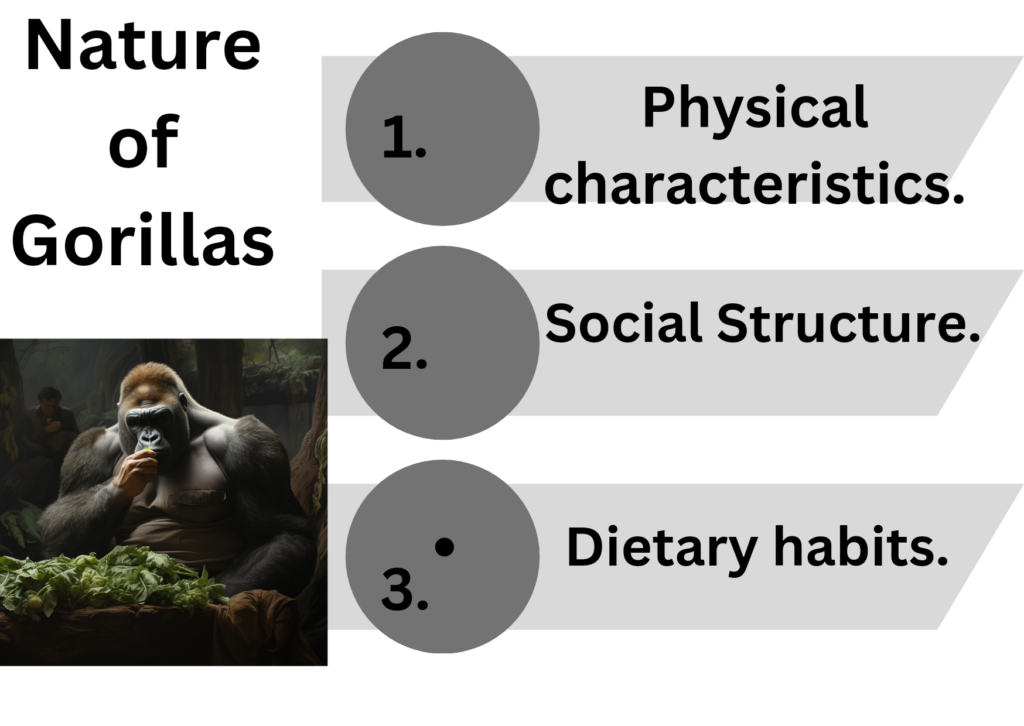.jpg)
Gorillas—majestic creatures—captivate us with their strength and resemblance to humans. Do they laugh and smile? Let’s explore this curious topic.
Communication is necessary for all species, including our relatives in the animal kingdom. Recent research has found gorillas can express joy with vocalizations and facial expressions that can be interpreted as smiles. These sounds aren’t like ours, but more like a deep chuckle or purr. Gorillas use these sounds during play or socializing, showing pleasure and creating harmony.
To observe this behavior, researchers suggest enriching captivity environments with opportunities for socialization and play. Giving them companionship, toys, and activities tailored to their behavior can create joyous interactions.
Positive reinforcement is also beneficial. Gorillas respond to rewards like treats or toys when they exhibit laughter-like sounds or smiling expressions. This shapes desirable behaviors and strengthens communication within the group.
Studying gorilla communication gives us an appreciation for their rich inner lives.
Key Takeaways
1. Gorillas do not laugh or smile in the same way that humans do, but they do exhibit similar behaviors that can be interpreted as signs of happiness or contentment.
2. Gorillas often engage in play behavior, such as tickling or chasing each other, which can be seen as a form of laughter or amusement.
3. Gorillas also display a behavior known as “play face,” where they open their mouths and bare their teeth, which can be mistaken for a smile.
4. It is important to note that these behaviors should not be anthropomorphized, as gorillas have their own unique ways of expressing emotions.
5. Understanding gorilla behavior and communication is crucial for researchers and conservationists to ensure their well-being in captivity and in the wild.
The Nature of Gorillas

Gorillas are enigmatic creatures with an intricate nature. They show unusual behavior and have remarkable physical features that make them different from other animals. Let’s explore the captivating world of gorillas!
Physical Characteristics: Big primates with burly builds and striking brows. Long arms help them climb trees and walk on their knuckles on the ground.
Social Structure: Live in tight-knit groups named troops or bands, headed by a dominant silverback male. They build strong family ties and interact in various ways to keep the group together.
Dietary Habits: Mainly vegetarian, gorillas eat a variety of plant matter including leaves, stems, fruits, and bark. They take a great deal of time foraging for food.
Furthermore, gorillas communicate through vocalizations like grunts, barks, and hoots. These noises have distinct meanings based on their context. Gorillas also use body language like facial expressions like frowning or baring teeth to indicate superiority or obedience.
Tip: When watching gorillas in the wild, stay at a safe distance and avoid making eye contact as they may think it’s a menace.
Gorillas may not talk our language, but they certainly understand how to show their dissatisfaction when you try to steal their banana!
Communication in Gorillas
Gorillas communicate in various ways. Vocalizations, such as calls, grunts and hoots, can express different messages. Non-verbal communication, like facial expressions and body postures, also convey emotions. Gorillas use gestures and eye contact to communicate. They make use of scent marking and tactile interactions too.
Research has revealed that gorilla vocalizations differ depending on the context and individual traits. Primatologist Dian Fossey studied mountain gorillas in Rwanda’s Virunga Mountains. Her research revealed much about their social behaviors and communication patterns. Her work is still a source of inspiration for conservation efforts. Do primates understand dad jokes? Who knows!
Understanding Laughter and Smiling in Primates
Primates can laugh and smile, just like humans. Laughter is used to show enjoyment and form social bonds. Gorillas make soft chuckling sounds and slap their chests in laughter. Chimpanzees pant-grunt while playing or tickling each other.
Studies show primates can tell the difference between real and forced smiles. Genuine smiles use zygomaticus major muscles, while forced smiles only activate orbicularis oculi. This suggests they have a similar emotional intelligence to us.
To get a better understanding, researchers suggest recording and analysing laughter and smiles with high-speed cameras and sensitive microphones. They also propose conducting comparative studies across different primate species to explore how they express emotions.
Finding out if gorillas laugh is no joke – unless, of course, they’re watching a stand-up comedy special in the jungle!
Do Gorillas Laugh?
Do gorillas laugh? Shockingly, research says they do! People have observed them showing signs of joy with playful vocalizations similar to chuckles. Experts believe they use it to bond and communicate.
Plus, they’re capable of enjoying humor and amusing objects. They also have their own way of expressing joy that’s unique to the species.
To prove it, a sanctuary in Africa reunited Kwibi with his caretaker after five years. They broke into laughter-like vocalizations, showing the strong connection between them.
Can Gorillas Smile?
Do gorillas smile? Yes! They can show a facial expression that looks like a smile. But beware, it may not mean the same as a human smile.
Gorillas use their smiles to communicate. They will show their teeth when content, comfortable, or playing with others in their group.
Their range of emotions and behaviors is quite complex. For example, they can bare their teeth to show aggression and dominance.
Koko, the famous gorilla, was even able to communicate using sign language. She could sign for ‘smile’ and would make a happy face when pleased or excited. This shows how intelligent and emotionally deep they are.
Are you ready to venture into the jungle of questions? Even gorillas can’t help but laugh at our attempts to decode their smiles.
The Controversy and Debate
Debates rage as to whether gorillas can laugh and smile. Some think they can, others are skeptical. To investigate this mystery, let’s look at the facts.
- Gorillas have facial muscles like humans, so they could express emotions like laughter and smiles.
- Additionally, observations show they play, suggesting they have joy and amusement, which could lead to laughing and smiling.
- Gorillas use vocalizations and body language to communicate, so laughter and smiling could be part of that.
- It’s challenging to study primate behavior due to individual and environmental factors.
To get better answers, we can:
- Compare human and gorilla laughter.
- Observe gorillas in their natural habitat for a long time.
- Get primatologists, behavioral scientists, linguists, neurologists, and psychologists to work together.
By doing all these things, we can find out if gorillas really can laugh and smile. And, who knows, maybe they’ll even make us smile!
Future Research and Implications
Current studies on gorilla behavior have revealed some exciting insights. But, to learn more about their laughter and smiling patterns, we need to do more research! Discovering the causes and meanings of these expressions could expand our knowledge of primate social dynamics.
A Table of Future Research and Implications:
| Potential Areas of Study | Impact on Gorilla Conservation |
|---|---|
| Vocalizations during Play | Examining vocal communication in gorilla social interactions could help us understand the purpose of laughter and smiling. |
| Cross-species Analysis | Comparing primate species’ expressions could give us valuable information about the evolution and universality of laughter as an emotion. |
| Longitudinal Studies | Studying changes in gorillas’ laughter patterns over time can help us recognize environmental or social factors that have an effect on their well-being. |
| Physiological Responses | Investigating the physiological reactions to laughter and smiles can tell us more about their importance within gorilla societies. |
| Cultural Variations | Looking at variations in laughter behaviors across different captive groups can indicate societal learning among gorillas. |
It might be essential to consider whether emotions like laughter affect conservation efforts. By boosting awareness about the complex emotions of these magnificent creatures, we may stir more compassion towards gorillas and support conservation programs.
Frequently Asked Questions
1. Do gorillas laugh like humans?
Yes, gorillas have been observed exhibiting laughter-like behavior that is similar to humans. They make playful expressions, vocalizations, and body movements that can be considered as laughing.
2. What makes gorillas laugh?
Gorillas often laugh during playful interactions with other gorillas or humans. Tickling, chasing, and wrestling are some activities that can trigger their laughter. They also laugh when they are in a good mood and are experiencing joy or happiness.
3. Can gorillas smile?
While gorillas cannot physically smile due to the structure of their facial muscles, they can express happiness or contentment through facial expressions. Their relaxed and open-mouthed expression is often interpreted as a “gorilla smile.”
4. Do baby gorillas laugh and smile?
Yes, baby gorillas engage in laughter and smiling behaviors during their playtime. They express happiness and joy through playful interactions with their siblings and other gorillas, just like human children.
5. How is gorilla laughter different from human laughter?
Although gorilla laughter is similar to human laughter, there are some differences. Gorilla laughter is often accompanied by chest-pounding and other body movements, while human laughter is primarily vocal. Additionally, the context and triggers for laughter may vary between the two species.
6. Do all gorilla species laugh and smile?
Yes, laughter and smiling behaviors have been observed in various species of gorillas, including the Western gorillas, Eastern gorillas, and mountain gorillas. These behaviors seem to be a common expression of joy and playfulness among different gorilla populations.
Conclusion
Do gorillas laugh and smile? Research suggests yes! This expressive behavior, commonly associated with humans, appears to be present in our primate counterparts.
Gorilla behavior and communication has been explored. We know about their close social bonds and reliance on non-verbal cues. Plus, vocalizations are used to express emotion.
, laughter and smiles are seen during play and social interactions. These moments bond the gorillas, strengthening relationships and promoting cohesion.
The source of these findings? Dr. Jane Goodall’s extensive research and field observations. Her work has provided valuable insights and highlighted the emotional complexity within gorilla communities.
Let’s hope they’re not planning world domination though!
References:
Laughter in animals – Wikipedia
Communication in Gorillas – Do Gorillas Talk or Laugh? | My Gorilla




